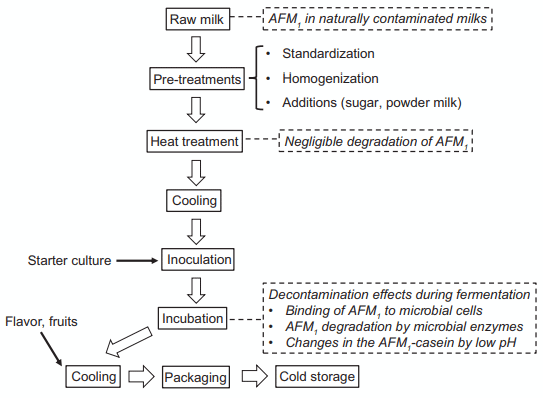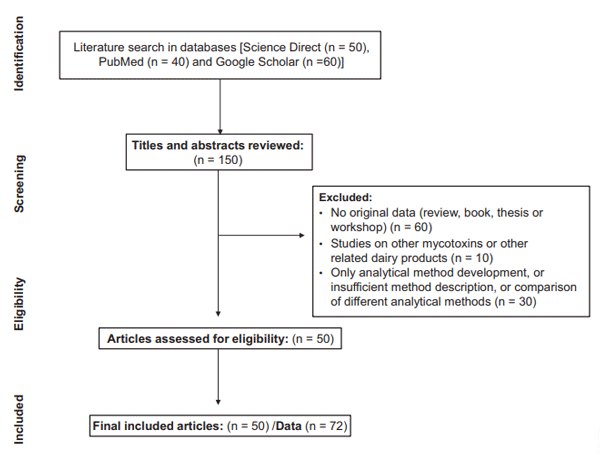The occurrence of aflatoxin M1 in industrial and traditional fermented milk: A systematic review study
Aflatoxin M1 (AFM1) is a toxic secreted into the milk of animals fed with diets contaminated by aflatoxin B1, which can cause some adverse health effects in humans. The occurrence of AFM1 in dairy products varies based on several factors, including the fermentation process. In this article, the published citations from January 2000 to October 2020 regarding the AFM1 occurrence in industrial and traditional fermented milk were systemically reviewed. According to the findings, a reducing trend in the AFM1 contamination of fermented milk was observed over the years, mainly in traditional products. Despite this trend, further control measures besides the preventative approaches are needed to deal with the high levels of AFM1 in fermented milk.
Keywords: AFM1 ; yogurt; fermented milk; occurrence; contamination; food safety; traditional dairy products
Introduction
Literature Search


The Occurrence of Aflatoxin M1 in Fermented Milk
Concluding Remarks
Conflict of interest statement
Agência Nacional de Vigilância Sanitária, 2011. Resolução RDC nº 7, de 18 de fevereiro de 2011. Diário Oficial da União—Seção 1, nº 37, 22 de fevereiro de 2011. pp. 72–73. Available at: http:// bvsms.saude.gov.br/bvs/saudelegis/anvisa/2011/res0007_ 18_02_2011_rep.hml.
Akkaya, L., Birdane, Y.O., Oguz, H. and Cemek, M., 2006. The occurrence of aflatoxin M1 in yogurt samples from Afyonkarahisar, Turkey. No. 50, Bulletin Veterinary Institute, Pulawy, 50: 517–519. Available at: https://www.researchgate.net/publication/256841530_Occurrence_of_aflatoxin_M1_in_yogurt_samples_from_Afyonkarahisar_Turkey
Aiad, A.S. and Aboelmakarem, H., 2013. Aflatoxin M1 levels in milk and some dairy products in Alexandria city. Assiut Veterinary Medical Journal 59(139): 94–98. Available at: http://www.aun. edu.eg/journal_files/119_J_1147.pdf
Al-Mossawei, M.T., Al-Zubaidi, L.A., Hamza, I.S. and Abduljaleel, S.Y., 2016. Detection of AFM1 in milk and some dairy products in Iraq using different techniques. Advances in Life Science Technology 41: 74–81. Available at: https://www. iiste.org/Journals/index.php/ALST/article/view/28597/29359
Anthony, M.H., Ojochenemi, A.D., Mulunda, M., Oriyomi, S.T., Jideofor, N.F., Tunde, O. and Isah, A., 2016. Aflatoxin M1 in breast milk, cow milk, and milk products in Minna, Nigeria and their predisposing factors. Biochemistry Analytical Biochemistry 5(4): 1–7. https://doi.org/10.4172/2161-1009.1000303
Arast, Y., Mohammadian, M. and Behnamipour, S., 2012. Occurrence of aflatoxin M1 in two dairy products by ELISA in central part of Iran. Life Science Journal 9(3): 1831–1833. https://doi.org/10.7537/marslsj090312.265
Atasever, M.A., Atasever, M. and Özturan, K., 2011. Aflatoxin M1 levels in retail yoghurt and ayran in Erzurum in Turkey. Turkish Journal of Veterinary and Animal Sciences 35(1): 59–62. Available at: https://journals.tubitak.gov.tr/veterinary/issues/ vet-11-35-1/vet-35-1-8-0906-96.pdf
Bahrami, R., Shahbazi, Y. and Nikousefat, Z., 2016. Aflatoxin M1 in milk and traditional dairy products from west part of Iran: occurrence and seasonal variation with an emphasis on risk assessment of human exposure. Food Control 62: 250–256. https://doi.org/10.1016/j.foodcont.2015.10.039
Barjesteh, M.H., Azizi, I.G. and Noshfar, E., 2010. Occurrence of aflatoxin M1 in pasteurized and local yogurt in Mazandaran province (northern Iran) using ELISA. Global Veterinaria 4(5): 459–462. Available at: http://idosi.org/gv/gv4(5)10/7.pdf
Barukčić, I., Bilandžić, N., Markov, K., Jakopović, K.L. and Božanić, R., 2018. Reduction in aflatoxin M1 concentration during production and storage of selected fermented milks. International Journal of Dairy Technology 71(3): 734–740. https://doi.org/10.1111/1471-0307.12490
Behfar, A., Khorasgani, Z.N., Alemzadeh, Z., Goudarzi, M., Ebrahimi, R. and Tarhani, N., 2012. Determination of aflatoxin M1 levels in produced pasteurized milk in Ahvaz City by using HPLC. Jundishapur Journal of Natural Pharmaceutical Products 7(2): 80–84. https://doi.org/10.5812/jjnpp.4707
Bhat, R., Rai, R.V. and Karim, A., 2010. Mycotoxins in food and feed: present status and future concerns. Comprehensive Reviews in Food Science and Food Safety 9(1): 57–81. https://doi. org/10.1111/j.1541-4337.2009.00094.x
Bilandzic, N., Bozic, D., Dokic, M., Sedak, M., Kolanovic, B.S., Varenina, I., Tankovic, S. and Cvetnic, Z., 2014. Seasonal effect on aflatoxin M1 contamination in raw and UHT milk from Croatia. Food Control 40: 260–264. https://doi.org/10.1016/j. foodcont.2013.12.002
Black, E.P., 2011. Dairy—fermented products. In: Heldman, D.R., Wheeler, M.B. and Hoover, D.G. (ed.), Encyclopedia of biotechnology in agriculture and food. Publishing Taylor and Francis, New York, pp. 195–199.
Campagnollo, F.B., Ganev, K.C., Khaneghah, A.M., Portella, J., Cruz, A.G., Granato, D., Corassin, C.H., Oliveira, C.A.F. and Sant’Ana, A.S., 2016. The occurrence and effect of unit operations for dairy products processing on the fate of aflatoxin M1 : a review. Food Control 68: 310–329. https://doi.org/10.1016/j. foodcont.2016.04.007
Cano-Sancho, G., Marin, S., Ramos, A.J., Peris-Vicente, J. and Sanchis, V., 2010. Occurrence of aflatoxin M1 and exposure assessment in Catalonia (Spain). Revista Iberoamericana de Micología 27(3): 130–135. https://doi.org/10.1016/j. riam.2010.05.003
Cano-Sancho, G., Perelló, G., Nadal, M. and Domingo, J.L., 2015. Comparison of the nutritional composition and the concentrations of various contaminants in branded and private label yogurts. Journal of Food Composition and Analysis 42: 71–77. https://doi.org/10.1016/j.jfca.2015.03.008
Daou, R., Afif, C., Joubrane, K., Khabbaz, L.R., Maroun, R., Ismail, A. and El Khoury, A., 2020. Occurrence of aflatoxin M1 in raw, pasteurized, UHT cows’ milk, and dairy products in Lebanon. Food Control 111: 5–29. https://doi.org/10.1016/j. foodcont.2019.107055
De Roma, A., Rossini, C., Ritieni, A., Gallo, P. and Esposito, M., 2017. A survey on the aflatoxin M1 occurrence and seasonal variation in buffalo and cow milk from Southern Italy. Food Control 81: 30–33. https://doi.org/10.1016/j.foodcont.2017.05.034
Di Guan, P.L., Zhang, Q., Wen, Z., Daohong Z. and Jun, J., 2011. An ultra-sensitive monoclonal antibody-based competitive enzyme Immunoassay for aflatoxin M1 in milk and infant milk products. Food Chemistry 125: 1359–1364. https://doi.org/10.1016/j. foodchem.2010.10.006
El Khoury, A., Atoui, A. and Yaghi, J., 2011. Analysis of aflatoxin M1 in milk and yogurt and AFM1 reduction by lactic acid bacteria used in Lebanese industry. Food Control 22(10): 1695–1699. https://doi.org/10.1016/j.foodcont.2011.04.001
European Commission, 2020. Available at: https://eur-lex.europa. eu/legal-content/EN/ALL/?uri=celex%3A32006R1881.
Fallah, A.A., 2010. Aflatoxin M1 contamination in dairy products marketed in Iran during winter and summer. Food Control 21: 1478–1481. https://doi.org/10.1016/j.foodcont.2010.04.017
Fallah, A.A., Rahnama, M., Jafari, T. and Saei-Dehkordi, S.S., 2011. Seasonal variation of aflatoxin M1 contamination in industrial and traditional Iranian dairy products. Food Control 22(10): 1653–1656. https://doi.org/10.1016/j.foodcont.2011.03.024
Food and Drug Administration Industry, 2000. Activities staff booklet. Available at: http://www.cfsan.fda.gov/~lrd/fdaact.html#afla.
Galvano, F., Galofaro, V., Ritieni, A., Bognanno, M., De Angelis, A. and Galvano, G., 2001. Survey of the occurrence of aflatoxin M1 in dairy products marketed in Italy: second year of observation. Food Additives and Contaminants 18(7): 644–646. https://doi. org/10.1080/02652030110035381
Gamba, R.R., Caro, C.A., Martínez, O.L., Moretti, A.F., Giannuzzi, L., De Antoni, G.L. and Peláez, A.L., 2016. Antifungal effect of kefir fermented milk and shelf life improvement of corn arepas. International Journal of Food Microbiology 235: 85–92. https://doi.org/10.1016/j.ijfoodmicro.2016.06.038
Gavahian, M., Mathad, G.N., Oliveira, C.A.F. and Mousavi Khaneghah, A., 2021. Combinations of emerging technologies with fermentation: interaction effects for detoxification of mycotoxins? Food Research International 141: 110104. https://doi. org/10.1016/j.foodres.2021.110104
Govaris, A., Roussi, V., Koidis, P.A. and Botsoglou, N.A., 2002. Distribution and stability of aflatoxin M1 during production and storage of youghurt. Food Additives and Contaminants 19(11): 1043–1050. https://doi.org/10.1080/0265203021000007831
Guo, L., Wang, Y., Fei, P., Liu, J. and Ren, D., 2019. A survey on the aflatoxin M1 occurrence in raw milk and dairy products from water buffalo in South China. Food Control 105: 159–163. https://doi.org/10.1016/j.foodcont.2019.05.033
Gürbay, A., Engin, A.B., Çağlayan, A. and Şahin, G., 2006. Aflatoxin M1 levels in commonly consumed cheese and yogurt samples in Ankara, Turkey. Ecology of Food and Nutrition 45(6): 449–459. https://doi.org/10.1080/03670240600985274
Hajmohammadi, M., Valizadeh, R., Naserian, A., Nourozi, M.E., Rocha, R.S. and Oliveira, C.A.F., 2020. Composition and occurrence of aflatoxin M1 in cow’s milk samples from Razavi Khorasan Province, Iran. International Journal of Dairy Technology 73: 40–45. https://doi.org/10.1111/1471-0307.12661
Hassan, H.F. and Kassaify, Z., 2014. The risks associated with aflatoxins M1 occurrence in Lebanese dairy products. Food Control 37: 68–72. https://doi.org/10.1016/j.foodcont.2013.08.022
Hassan, Z.U., Al-Thani, R., Atia, F.A., Almeer, S., Balmas, V., Migheli, Q. and Jaoua, S., 2018. Evidence of low levels of aflatoxin M1 in milk and dairy products marketed in Qatar. Food Control 92: 25–29. https://doi.org/10.1016/j.foodcont.2018.04.038
Ibrahim, D.K., El-Zamik, F.I., Mohamed, G.E. and Abdl El-Basit, H.M., 2016. Determination of aflatoxin M1 levels in milk and some dairy products. Zagazig Journal of Agricultural Research 43(1): 151– 163. https://doi.org/10.21608/zjar.2016.101576
Iha, M.H., Barbosa, C.B., Okada, I.A. and Trucksess, M.W., 2011. Occurrence of aflatoxin M1 in dairy products in Brazil. Food Control 22(12): 1971–1974. https://doi.org/10.1016/j. foodcont.2011.05.013
Iha, M.H., Barbosa, C.B., Okada, I.A. and Trucksess, M.W., 2013. Aflatoxin M1 in milk and distribution and stability of aflatoxin M1 during production and storage of yoghurt and cheese. Food Control 29(1): 1–6. https://doi.org/10.1016/j. foodcont.2012.05.058
Imamura, K.B., Ton. J.C.V. and Glannon, J.A., 2015. Incidence of aflatoxins in peanuts (Arachis hypogaea L) in the state of São Paulo. Revista Analítica 75: 49–54.
International Agency for Research on Cancer, 2002. Some traditional herbal medicines, some mycotoxins, naphthalene and styrene. IARC Monographs on the Evaluation of Carcinogenic Risks to Humans 82: 171–175. Available at: https://publications.iarc.fr/Book-And-Report-Series/Iarc-Monographs-OnThe-Identification-Of-Carcinogenic-Hazards-To-Humans/ Some-Traditional-Herbal-Medicines-Some-MycotoxinsNaphthalene-And-Styrene-2002
Iqbal, S.Z. and Asi, M.R., 2013. Assessment of aflatoxin M1 in milk and milk products from Punjab, Pakistan. Food Control 30(1): 235–239. https://doi.org/10.1016/j.foodcont.2012.06.026
Iqbal, S.Z., Asi, M.R. and Jinap, S.J.F.C., 2013. Variation of aflatoxin M1 contamination in milk and milk products collected during winter and summer seasons. Food Control 34(2): 714–718. https://doi.org/10.1016/j.foodcont.2013.06.009
Iqbal, S.Z., Asi, M.R. and Malik, N., 2017. The seasonal variation of aflatoxin M1 in milk and dairy products and assessment of dietary intake in Punjab, Pakistan. Food Control 79: 292–296. https://doi.org/10.1016/j.foodcont.2017.04.015
Iqbal, S.Z., Jinap, S., Pirouz, A.A. and Faizal, A.A., 2015. Aflatoxin M1 in milk and dairy products, occurrence and recent challenges: a review. Trends in Food Science and Technology 46(1): 110–119. https://doi.org/10.1016/j.tifs.2015.08.005
Ismaiel, A.A., Tharwat, N.A., Sayed, M.A. and Gameh, S.A., 2020. Two-year survey on the seasonal incidence of aflatoxin M1 in traditional dairy products in Egypt. Journal of Food Science and Technology 1–8. https://doi.org/10.1007/s13197-020-04254-3
Issazadeh, K., Darsanaki, R.K. and Pahlaviani, M.K., 2012. Occurrence of aflatoxin M1 levels in local yogurt samples in Gilan Province, Iran. Annals Biological Research 3(8): 3853– 3855. Available at: https://www.scholarsresearchlibrary.com/ articles/occurrence-of-aflatoxin-m1-levels-in-local-yogurt-samples-in-gilan-province-iran.pdf
Ivastava Sr, V.P., Bu-Abbas, A., Al-Johar, W., Al-Mufti, S. and Siddiqui, M.K.J., 2001. Aflatoxin M1 contamination in commercial samples of milk and dairy products in Kuwait. Food Additives and Contaminants 18(11): 993–997. https://doi. org/10.1080/02652030110050357
Jalili, M. and Scotter, M., 2015. A review of aflatoxin M1 in liquid milk. Journal of Health Safety Environment 2: 283–295. Available at: https://core.ac.uk/download/pdf/270218742.pdf
Jasim, H.N. and Najim, N.H., 2014. The occurrence of aflatoxin M1 in milk, soft cheese and yoghurt in Baghdad Province by using ELISA test. The Iraqi Journal of Veterinary Medicine 38(2): 9–16. Available at: https://ijvm.iraqjournals.com/pdf_97461_ dd1011166024f7697ae076f16a9d0c60.html
Kamkar, A., 2005. A study on the occurrence of aflatoxin M1 in raw milk produced in Sarab city of Iran. Food Control 16(7): 593– 599. https://doi.org/10.1016/j.foodcont.2004.06.021
Keskić, T., Miočinović, J., Kos, A., Gavrić, M., Miloradović, Z. and Pudja, P., 2016. Seasonal variations of aflatoxin M1 in dairy products during 2015 in Serbia. Second International Symposium of Veterinary Medicine, Belgrade, pp. 226–232.
Kim, E.K., Shon, D.H., Ryu, D., Park, J.W., Hwang, H.J. and Kim, Y.B., 2000. Occurrence of aflatoxin M1 in Korean dairy products determined by ELISA and HPLC. Food Additives and Contaminants 17(1): 59–64. https://doi.org/10.1080/026520300283595
Kim–Soo, K.R.L.M. and Chung, H., 2016. Aflatoxin M1 levels in dairy products from South Korea determined by high performance liquid chromatography with fluorescence detection. Journal of Food and Nutrition Research 55(2): 171–180. https:// doi.org/10.1080/026520300283595
Kuboka, M.M., Imungi, J.K., Njue, L., Mutua, F., Grace, D. and Lindahl, J.F., 2019. Occurrence of aflatoxin M1 in raw milk traded in peri-urban Nairobi, and the effect of boiling and fermentation. Infection Ecology and Epidemiology 9(1): 1–8. https://doi. org/10.1080/20008686.2019.1625703
Langat, G., Tetsuhiro, M., Gonoi, T., Matiru, V. and Bii, C., 2016. Aflatoxin M1 contamination of milk and its products in Bomet County, Kenya. Advances in Microbiology 6(7): 528. https://doi. org/10.4236/aim.2016.67053
Lin, L.C., Liu, F.M., Fu, Y.M. and Shih, D.C., 2004. Survey of aflatoxin M1 contamination of dairy products in Taiwan. Journal of Food and Drug Analysis 12(2): 154–160. https://doi. org/10.38212/2224-6614.2652
Lindahl, J.F., Kagera, I.N. and Grace, D., 2018. Aflatoxin M1 levels in different marketed milk products in Nairobi, Kenya. Mycotoxin Research 34(4): 289–295. https://doi.org/10.1007/ s12550-018-0323-4
Mahmood Fashandi, H., Abbasi, R. and Mousavi Khaneghah, A., 2018. The detoxification of aflatoxin M1 by Lactobacillus acidophilus and Bifidobacterium spp.: a review. Journal of Food Processing and Preservation 42: e13704. https://doi.org/10.1111/ jfpp.13704
Martins, M.L. and Martins, H.M., 2004. Aflatoxin M1 in yoghurts in Portugal. International Journal of Food Microbiology 91(3): 315–317. https://doi.org/10.1016/S0168-1605(02)00363-X
Mason, S., Arjmandtalab, S., Hajimohammadi, B., Khosravi Arsanjani, A., Karami, S., Sayadi, M. and Oryan, A., 2015. Aflatoxin M1 contamination in industrial and traditional yogurts produced in Iran. Journal of Food Quality and Hazards Control 2(1): 11–14. Available at: http://jfqhc.com/article-1-107-en.pdf
Mousavi Khaneghah, A., Chaves, R.D. and Akbarirad, H., 2017. Detoxification of aflatoxin M1 (AFM1 ) in dairy base beverages (acidophilus milk) by using different types of lactic acid bacteria-mini review. Current Nutrition & Food Science 13: 78–81. https://doi.org/10.2174/1573401313666170102162930
Muaz, K., Riaz, M., Oliveira, C.A.F., Akhtar, S., Ali, S.W., Nadeem, H., Park, S. and Balasubramanian, B., 2021. Aflatoxin M1 in milk and dairy products: global occurrence and potential decontamination strategies. Toxin Reviews. https://doi.org/10.1 080/15569543.2021.1873387
Nadira, A.F., Rosita, J., Norhaizan, M.E. and Redzwan, S.M., 2017. Screening of aflatoxin M1 occurrence in selected milk and dairy products in Terengganu, Malaysia. Food Control 73: 209–214. https://doi.org/10.1016/j.foodcont.2016.08.004
Nejad, A.S.M., Heshmati, A. and Ghiasvand, T., 2019. The occurrence and risk assessment of exposure to aflatoxin M1 in ultrahigh temperature and pasteurized milk in Hamadan province of Iran. Osong Public Health and Research Perspectives 10(4): 228. https://doi.org/10.24171/j.phrp.2019.10.4.05
Nikbakht, M.R., Lachiniyan, S., Rahbar, S., Oubari, F., Rostami, Z. and Tajehmiri, A., 2016. Aflatoxin M1 contamination in traditional yoghurts produced in Guilan province, Iran. Asian Journal of Pharmaceutical Research and Health Care 8(1): 1–3. https:// doi.org/10.18311/ajprhc/2016/663
Nilchian, Z. and Rahimi, E., 2012. Aflatoxin M1 in yoghurts, cheese and ice-cream in Shahrekord-Iran. World Applied Sciences Journal 19(5): 621–624. Available at: https://citeseerx.ist.psu.edu/ viewdoc/download?doi=10.1.1.390.1323&rep=rep1&type=pdf
Otles, S. and Cagindi, O., 2003. Kefir: a probiotic dairy-composition, nutritional and therapeutic aspects. Pakistan Journal of Nutrition 2(2): 54–59. https://doi.org/10.3923/pjn.2003.54.59
Rabie, M., El-Wahed, A., Moustafa, M.G., El-Zahar, K. and AbdelZaher, A.M., 2019. The role of probiotic bacteria in protecting against aflatoxin M1 contamination in milk and certain dairy products. Journal of Food and Dairy Sciences 10(4): 93–99. https://doi.org/10.21608/jfds.2019.36183
Rahimi, E., 2014. Survey of the occurrence of aflatoxin M1 in dairy products marketed in Iran. Toxicology and Industrial Health 30(8): 750–754. https://doi.org/10.1177/0748233712462476
Rahmani, J., Alipour, S., Miri, A., Fakhri, Y., Riahi, S.-M., Keramati, H., Moradi, M., Amanidaz, N., Pouya, R.H., Bahmani, Z. and Mousavi Khaneghah, A., 2018. The prevalence of aflatoxin M1 in milk of Middle East region: a systematic review, meta-analysis and probabilistic health risk assessment. Food and Chemical Toxicology 118: 653–666. https://doi.org/10.1016/j. fct.2018.06.016
Ruangwises, N. and Ruangwises, S., 2010. Aflatoxin M1 contamination in raw milk within the central region of Thailand. Bulletin of Environmental Contamination and Toxicology 85: 195–198. https://doi.org/10.1007/s00128-010-0056-3
Sadiq, F.A., Yan, B., Tian, F., Zhao, J., Zhang, H. and Chen, W., 2019. Lactic acid bacteria as antifungal and anti-mycotoxigenic agents: a comprehensive review. Comprehensive Reviews in Food Science and Food Safety 18: 1403–1436. https://doi. org/10.1111/1541-4337.12481
Sahin, H.Z., Celik, M., Kotay, S. and Kabak, B., 2016. Aflatoxins in dairy cow feed, raw milk and milk products from Turkey. Food Additives and Contaminants: Part B 9(2): 152–158. https://doi. org/10.1080/19393210.2016.1152599
Sarica, D.Y., Has, O., Tasdelen, S. and Ezer, Ü., 2015. Occurrence of aflatoxin M1 in milk, white cheese and yoghurt from Ankara, Turkey markets. Biological and Chemical Research 36–49. Available at: http://www.ss-pub.org/wp-content/ uploads/2015/01/BCR2014103002.pdf
Sohrabi, N. and Gharahkoli, H., 2016. A seasonal study for determination of aflatoxin M1 level in dairy products in Iranshahr, Iran. Current Medical Mycology 2(3): 27. https://doi.org/10.18869/ acadpub.cmm.2.3.27
Temamogullari, F. and Kanici, A., 2014. Aflatoxin M1 in dairy products sold in Şanlıurfa, Turkey. Journal of Dairy Science 97(1): 162–165. https://doi.org/10.3168/jds.2012-6184
Udomkun, P., Mutegi, C., Wossen, T., Atehnkeng, J., Nabahungu, N.L., Njukwe, E. and Bandyopadhyay, R., 2018. Occurrence of aflatoxin in agricultural produce from local markets in Burundi and Eastern Democratic Republic of Congo. Food Science and Nutrition 6(8): 2227–2238. https://doi.org/10.1002/fsn3.787
Wild, C.P., Miller, J.D. and Groopman, J.D., 2015. Mycotoxin control in low-and middle-income countries. IARC Publications, Lyon, France. Available at: https://publications.iarc.fr/BookAnd-Report-Series/Iarc-Working-Group-Reports/MycotoxinControl-In-Low--And-Middle-income-Countries-2015
Zhou, Y., Xiong, S., Zhang, K., Feng, L., Chen, X., Wu, Y. and Xiong, Y., 2019. Quantum bead-based fluorescence-linked immunosorbent assay for ultrasensitive detection of aflatoxin M1 in pasteurized milk, yogurt, and milk powder. Journal of Dairy Science 102(5): 3985–3993. https://doi.org/10.3168/ jds.2018-16109








